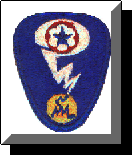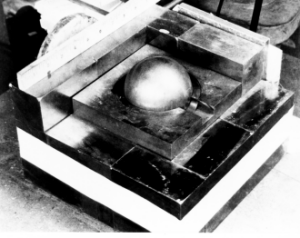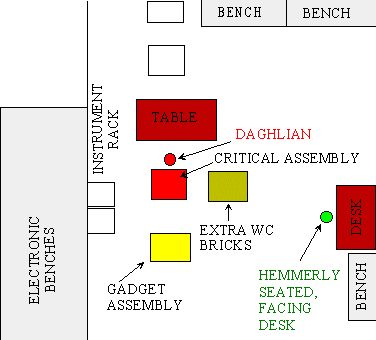
As scheduled, Baker, Holloway, King and Schreiber arrived at the Los Alamos facility in the autumn of 1943, while Daghlian stayed behind to help with rebuilding the Purdue cyclotron, restoring it to produce 10-MeV deuterons. At this point, he also needed to complete his course work at Purdue, typically two years in duration, which would then allow him to devote full-time to his doctoral thesis project at Los Alamos. Daghlian probably started working at Los Alamos in the late spring of 1944 as a member of the "Water Boiler" group at the Omega Site; he later joined the Critical Assembly Group or "crew" that was headed by Otto Frisch, also located at Omega. These studies included the well-known "tickling the dragon's tail" experiments. Daghlian's last major assignment was as an assistant in preparing the plutonium core at the MacDonald Ranch House for the Trinity test in Alamogordo, NM (16 July, 1945). [ Inset : Embroidered shoulder patch awarded to 3500 participants of the Manhattan Project.]
On 21 August, 1945, Daghlian was involved with a series of experiments at Omega Site concerning the critical masses of a 6.2 kg sphere of plutonium (Pu-239 or "49 metal") in various tungsten carbide (WC) tamper arrangements. On the morning of August 21, 1945, he constructed a hollow cube on a square base (14-7/8 inches per side) from WC bricks (2-1/8 x 2-1/8 x 4-1/4 inches) surrounding the 49 metal sphere. This assembly was found to be critical when five layers were completed and two additional bricks were placed in the middle of the sixth layer.

That afternoon, Daghlian constructed another cube on a 12-3/4 inch square base of WC bricks for enclosing the same 49 metal sphere. This time, the assembly became critical when five layers were completed, and the task of designing an appropriate assembly configuration, i.e., the 49 metal sphere enclosed in a completed cube, remained to be determined. As he disassembled the afternoon experiment and returned the Pu-239 sphere to the vault, Daghlian began planning the next criticality test and, after making some final remarks in his notebook, he decided to construct the next assembly on a 10-5/8 inch square base. [ Inset: Photo of the critical assembly after the accident and dismantling by Daghlian. A nickel-plated sphere of 49 metal is shown supported by a WC cradle and surrounded by a base of WC bricks. During a test, a neutron source is first placed into the hollow center of the shere (composed of two hemispheres) and covered with a matching top WC cradle. The assembly is subcritical in this configuration. The WC tamper functions to "reflect" neutrons back to the center sphere of plutonium causing increasing fissions which also release additional neutrons. In Daghlian's case, too much tamper was accidently added when the WC brick fell from his hand and the assembly became "critical".]
After dinner, Daghlian attended a scientific lecture at theatre #2, and began thinking about returning to Omega Site that evening to test the third assembly, rather than the following morning as originally planned. He was well aware that this was against "official" safety regulations on two counts, i.e., performing a potentially hazardous experiment alone after-hours. By the end of the lecture at 9:10 PM, his mind was made up, for reasons that are even today unknown, and he proceeded directly to Omega, arriving there at 9:30 PM.
Entering the laboratory, he found Private Robert J. Hemmerly, a Special Engineer Detachment (SED) guard, seated at a desk and reading a newspaper. Hemmerly looked up apprehensively at a somewhat anxious Daghlian, who tried to mask his nervousness by walking directly to the assembly bench. SED guards were stationed at Omega whenever fissionable material was onsite, in case of fire and, especially, as a deterrent to theft. Hemmerly's responsibilities did not extend to policing conduct or enforcing laboratory regulations, and his apprehension quickly faded with a return to his newspaper and a "Hi, Harry" in the direction of the moving figure.

Daghlian immediately set about removing the 49 metal sphere from the vault and constructing the planned assembly. Using the audible "clicks" of the monitoring instruments as a guide, he quickly completed four layers. His pace slowed as he started the fifth layer and he finished half of it. As he attempted to place another brick over the center of the assembly with his left hand, the "clicks" alerted him to the possibility that this addition would be supercritical, and he immediately started withdrawing his left hand when the brick fell from his grasp into the center of the assembly. Reacting instinctively, he pushed the brick from the assembly with his right hand, which developed a tingling sensation as it became enveloped in the blue glow surrounding the sphere. The time was 9:55 PM.
When the accident occurred, Hemmerly was seated with his back to the assembly some twelve feet away. Even so, the rapid succession of instrument "clicks", the thud of the falling brick, and the bright flash of light hardly escaped his notice as he turned in the direction of the assembly. At that moment, Daghlian's large figure was standing limply with his arms suspended at his sides, attempting to rationally assess the situation in spite of a flood of varied emotions ranging from embarrassment to fear of the possible consequences he had created. For now, he decided to partially dismantle the assembly to a more stable configuration, and subsequently informed Hemmerly of the situation. By chance, another graduate student had just arrived at Omega and she drove Daghlian to the hospital at Los Alamos, while Hemmerly stayed behind to alert Sargeant Starner, who was in a protected office area at Omega separated by a five-foot-thick concrete wall from the laboratory, that an accident had occurred.

 Next Page
Next Page

 Home
Home